|
|
The Bead
Rescue Project for
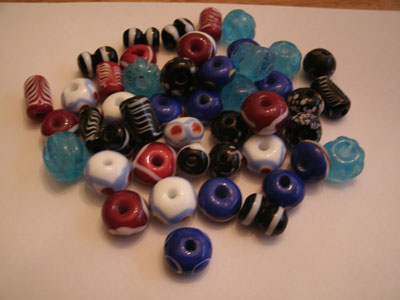
The Known
World Seneschal Event
Welcome to The Bead
Rescue Project! Please visit our homepage,
for more information on the project at
http://beadrescue.com
Beads were a tradable
commodity, and moved around the world and throughout cultures
via the shipping routes. All beads in period were handmade, thus no
2 were ever alike,
nor were they perfect.
8 types of beads were
hidden for this event. All are included on this page!
|
Bead No. |
Picture |
Type |
Information & Documentation |
|
S12-1 |

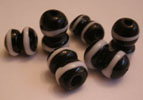 |
Segmented |
Time Periods: All
Culture: All
Segmented beads were made prior to 600AD - 1600AD. Most
were plain an undecorated. Those that were were more
often a foil bead, most often made by the Chinese or
Middle Eastern Cultures prior to and in the earlier part
of the time period. They were made and liked by all
cultures including Romans, and Anglo-Saxons, just to
name a few.
"Magical
Ancient Beads" Pg. 43 |
|
S12-2 |

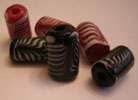 |
Trailed |
Time Periods: All
Cultures: Islamic
The Middle Eastern and Asian cultures were the ones most
noted for the trailed or raked beads. Like most
other beads, they did make their way through the trade
routes, however were found most often in the Islamic and
Middle Eastern gravesites.
"Middle
Eastern and Venetian Glass Beads" Pg. 72 |
|
S12-3 |

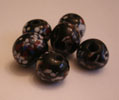 |
Crumb |
Time Periods:All
Cultures:All
These beads were also called "End of Day"beads. The
decoration was created using the bits of glass, that
broke off, during the days work. These beads were
found in just about every shape and many colors.
"Middle
Eastern and Venetian Glass Beads" Pg. 43 |
|
S12-4 |
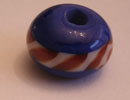
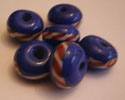 |
Twisted
Stringer |
Time Periods: All
Cultures: All
These were simple annular beads, decorated by applying a
stringer, twisted of 2 different colors. Most
often a white or yellow paired with a red, black or
other dark color. Blue was the predominant color
of the base bead, however there have been green and
black base beads found as well!
Dark
Ages Recreation Company, Color Plate 2, Page 2 |
|
S12-5 |

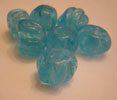 |
Melon |
Time Periods: All
Cultures: All
This was another very popular, easy to make, yet pretty
style of bead. They were made in just about every color
of glass, and found in every culture!
"Asia's
Maritime Bead Trade 300 B.C. to the Present" Color Plate
14 |
|
S12-6 |
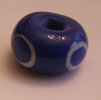
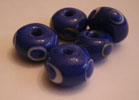 |
Eye |
Time Periods: All
Cultures: All
These beads are most common throughout all cultures. The
eye was believed to protect the wearer from evil.
These bead types have been found as old as glass, and
even faince, an earthen ceramic precursor to glass.
"The
Glass Beads of the Prehistoric and Roman Periods in
Britainand Ireland" Color Plate 1, Figure 1 |
|
S12-7 |
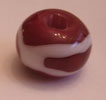
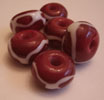 |
Wavy |
Time Periods: All
Cultures: All
Wavy and Zig Zag lines were applied in all cultures on
various beads. The zig zag, wavy, and criss
crossing lines were often applied in order to "confuse"
evil energies, thus protecting the wearer from evil.
"Glass
Beads from Early Anglo-Saxon Graves" Figure 161 |
|
S12-8 |
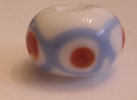
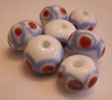 |
Wavy with
Dot |
Time Periods:
Cultures: Anglo-Saxon
Although this bead pattern is most definitely
Anglo-Saxon, this color combination was found only in
England.
"Glass
Beads from Early Anglo-Saxon Graves" figure 163 #2 |
|